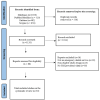Traumatic Dental Injuries' Prevalence across Diverse Healthcare Settings: A Systematic Review and Meta-Analysis
- PMID: 39465059
- PMCID: PMC11512718
- DOI: 10.22037/aaem.v13i1.2432
Traumatic Dental Injuries' Prevalence across Diverse Healthcare Settings: A Systematic Review and Meta-Analysis
Abstract
Introduction: Traumatic dental injuries (TDI) are a global public health concern, impacting individuals of various age groups. This systematic review aimed to consolidate current evidence on TDI prevalence, providing insights for improved management and prevention strategies.
Methods: A comprehensive search was conducted across PubMed/MEDLINE, Embase, and Scopus databases for studies published between January 1, 2000, and July 1, 2024. Studies reporting on the prevalence of TDI in various populations were included. We followed PRISMA guidelines in the review process. Descriptive statistics were used to summarize study characteristics, and a random-effects model was applied in the meta-analysis using STATA version 14 to pool prevalence rates, while accounting for inter-study variability. Begg's and Egger's tests were conducted to assess publication bias.
Results: The review included data of 151,205 patients from 30 studies across diverse healthcare settings. The prevalence rates varied significantly across studies, ranging from as low as 1.88% to as high as 86.98%. The overall pooled prevalence of TDI, calculated using a random effects model, was 19.48% (95% CI: 11.21% to 27.74%), indicating substantial heterogeneity among the studies (I-squared = 100.0%, p < 0.001). The prevalence varied significantly across different healthcare settings and demographic groups. No evidence of publication bias was found (p > 0.05).
Conclusions: This systematic review underscores the high prevalence of TDI and highlights the need for targeted preventive strategies and evidence-based interventions in dental trauma care.
Keywords: Dental care; Meta-analysis; Pediatric dentistry; Prevalence; Tooth injuries.
Conflict of interest statement
The authors declare that they have no competing interests relevant to this study.
Figures
References
-
- Glendor U. Epidemiology of traumatic dental injuries–a 12 year review of the literature. Dent Traumatol. 2008;24(6):603–11. - PubMed
-
- Petti S, Glendor U, Andersson L. World traumatic dental injury prevalence and incidence, a meta‐analysis—One billion living people have had traumatic dental injuries. Dent Traumatol. 2018;34(2):71–86. - PubMed
-
- Rajab LD, Abu Al Huda D. Impact of treated and untreated traumatic dental injuries on oral health‐related quality of life among 12‐year‐old schoolchildren in Amman. Dent Traumatol. 2019;35(3):153–62. - PubMed
-
- Lee JY, Divaris K. Hidden consequences of dental trauma: the social and psychological effects. Ped dent. 2009;31(2):96–101. - PubMed
Publication types
LinkOut - more resources
Full Text Sources



